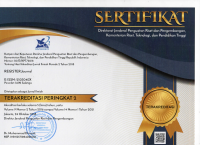Development of Comma 2.0 as an English learning application for early childhood using the Quality Function Deployment (QFD) method
Abstract
Comma 2.0 is an English learning application for early childhood that is specifically created for TK Roudlotul Muttaqin Mojokerto. . The purpose of this research was to process user feedback regarding the comparison of the development of Comma 2.0 with the previous version by using the Quality Function Deployment method in order to provide more optimal development in accordance with the users' expectations. One of the methods proven to be effective in language learning was Total Physical Response (TPR), which emphasized learning English by using three important aspects: commands, speaking, and actions. The research employed an experimental design with 15 children aged 4–6 years as participants. Data were collected through structured observations and user feedback assisted by teachers and parents, and analyzed using the Quality Function Deployment (QFD). The analysis focused on five attributes: material comprehension, application usability, attractiveness of animated characters, clarity of sound and visuals, and ease of imitating animations and sounds. From the results of the research, it could be concluded that the Comma 2.0 application was easy to use, contained easy-to-understand materials, and featured attractive animated characters with clear images and sounds that were easy to imitate by the application users.
Keywords
Full Text:
PDFDOI: https://dx.doi.org/10.30659/e.10.2.471-487
Refbacks
- There are currently no refbacks.
Copyright (c) 2025 kinanti resmi hayati, Heru Prasetiyo Utomo, Radityo Anggoro, Tranggono Tranggono, Afita Dewi Prastiwi, Albertus Adriyanto Sakti Prakosa, Aldi Pramoedya Nugroho
License URL: https://creativecommons.org/licenses/by/4.0/










